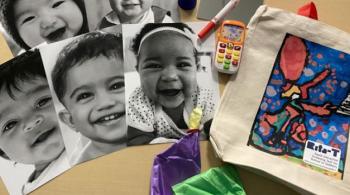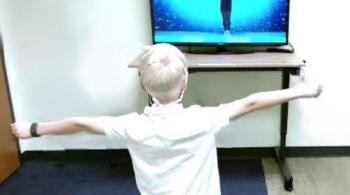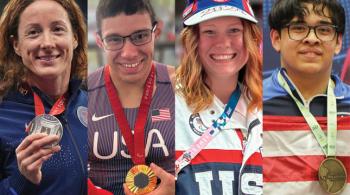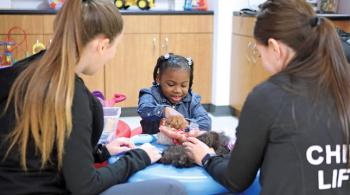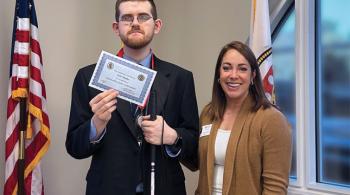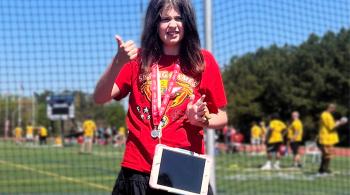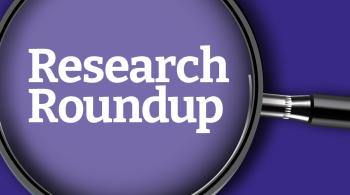April is known internationally as Autism Acceptance Month, providing an opportunity to think about and deepen our understanding of the complexities of this neurodevelopmental diagnosis and the varied lived experiences of people who have been diagnosed with autism.
Over the decades since autism was first described, there have been significant changes not only in how we diagnose autism, but also in our understanding of autism and its causes. To share this conversation during Autism Acceptance Month with Dr. Brad Schlaggar, President and CEO of Kennedy Krieger is his guest: Dr. Rebecca Landa, Founder and executive director of the Center for Autism Services, Science and Innovation.
Learn More About Kennedy Krieger Faculty & Staff Members Featured in This Episode
Learn More About Kennedy Krieger Faculty & Staff Members Featured in This Episode

Rebecca
Landa
,
PhD, CCC-SLP
View Episode Transcription
Dr. Brad Schlaggar: Welcome to Your Child's Brain, a podcast series produced by Kennedy Krieger Institute with assistance from WYPR. I'm Dr. Brad Schlaggar, Pediatric Neurologist, and President and CEO of Kennedy Krieger Institute. April is known internationally as Autism Acceptance Month, providing an opportunity to think about and deepen our understanding of the complexities of this neurodevelopmental diagnosis and the varied lived experiences of people who have been diagnosed with autism. Autism spectrum disorder is a neurological and developmental disorder that affects how people interact with others, communicate, learn, and behave. Although autism can be diagnosed at any age after the first birthday, it is described as a developmental disorder because characteristics generally appear in the second year of life with subtle developmental differences appearing during infancy. The autism experience is different for everyone, which is why it is referred to as a spectrum. The first clinical publication describing autism, referred then as infantile autism was published in 1943 by Dr. Leo Kanner, a child psychiatrist at Johns Hopkins. In the intervening 82 years, there have been significant changes, not only in how we diagnose autism, but also in our understanding of autism and its causes, including blaming parents for their parenting styles, which has thankfully given way to a focus on a growing and robust body of evidence for genetic and neurological factors. Today, we understand that autism spectrum disorder has no single known cause, given its complexity and the variety of its features, characteristics, including the range of their severity. It stands to reason that there are many causes or pathways leading to autism. Including interactions between genetics and environment. To share this conversation with me during Autism Acceptance Month is my guest, Dr. Rebecca Landa. Dr. Landa is the founder and executive director of the Kennedy Krieger Center for Autism Services, Science and Innovation, or CASSI, formerly known as CARD, the Center for Autism and Related Disorders. An internationally respected speech language pathologist and scientist, Dr. Landa is also a professor of psychiatry and behavioral sciences at the Johns Hopkins University School of Medicine. I also want to acknowledge and celebrate that 2025 marks a significant milestone for CASSI. As we celebrate this year, it's 30th anniversary. So welcome, Becky. Before we get started, I'd like to acknowledge that in the autism advocacy community, there are varying perspectives on certain aspects of language usage. Some prefer the use of person first language. For example, John is a person with autism. Others prefer the use of identity first language. For example, Sally is an autistic person. At Kennedy Krieger, we recognize and respect both of these perspectives. Consequently, we will use the language interchangeably, and whenever possible, we'll ask an individual how they would like to be identified. You will hear us use both interchangeably today. Becky, 30 years ago, autism looked very different than it does today. How did your vision to establish a center like CASSI come to be?
Dr. Rebecca Landa (RL): Thank you for asking and hello. I'm so excited to be with you today. At the time that I established CASSI, there were no other centralized interdisciplinary programs that provided the range of assessment, diagnosis, and treatment that autistic individuals and their families needed, or where clinical care, research, and training were seamlessly integrated. I came to understand the significant need for such a center through my post doctoral training experiences that took me into the homes of families of an autistic child. The parents shared heartbreaking stories about how their child had been misdiagnosed and how they had been given disappointing news about their child's developmental prognosis, and even what could be done to help their child. Those stories and seeing the family struggle led me to design and establish CASSI. As I was designing CASSI, I asked myself, how could CASSI help address the gaps and barriers that families and autistic individuals are experiencing? I knew that diagnosing and treating autism and the co-occurring conditions required specialized knowledge. I staffed CASSI with a variety of experts from a variety of fields who would be trained to the highest level of what we would know in the science at the time. Also, I wanted for CASSI to be able to provide up to the moment science informed care. I wanted for our team to be able to systematically learn from our patients about what their priorities were and where were the gaps in knowledge and also to be able to leverage discoveries from other fields. I designed CASSI to have a strong, multifaceted, internationally engaged center of scientific innovation and discovery, and then also an arm within CASSI that would translate those findings into practices that the community at large could adopt.
BS: An important part of your background is that you're a clinician, a speech language pathologist. I'm wondering how that training and perspective impacted your vision for CASSI.
RL: Thank you. As a speech pathologist, I was working with children's social cognitive development, their communication development, and of course, many autistic children have difficulty with their motor system. There were difficulties with learning to use speech for communication or even gesture. As I was working with them in these regards, I came to see how the gaps in our knowledge were really affecting them, and that also their sensory differences were making it difficult for them to make progress and their insistence on sameness, let's say. But some of them also were having significant anxiety. I thought, gosh, where do you go for help with these things? I knew at that point that we had to have this interdisciplinary team of representing many professions coming together to help these kids and families.
BS: How has CASSI, I mentioned it's the 30th anniversary. How would you characterize the evolution of CASSI over those three decades now?
RL: Well, we started off with one full time person and a few part time people. The good news was at that time, those people were from key fields like child and adolescent psychiatry, neurology, psychology, social work. But clearly the need was far beyond what that small skeletal crew could provide care for. Now we have four sites with over 250 interdisciplinary staff and infrastructure and research staff and see over 7,000 different patients through 54,000 visits. But I think it's also important to mention another specialized part of our clinical care program, and that is the Achievements Program. I designed Achievements the first year that I started CASSI in 1995 because at that time, there really weren't clear treatment pathways. There was either a very I would say, highly structured adult led applied behavior analysis approach or a very follow the child's lead approach. I just knew that the brain doesn't work that way, that we had to marry these two things. That's now called naturalistic developmental behavioral intervention or NDBI. The other thing that I knew was that you really needed to provide autistic children early in life with the experiences like in a classroom with other children that would get them ready for when they would enter preschool or kindergarten. The achievements program is a classroom based program. We've now done research with this and shown that it's effective, and we now have 14 achievements classrooms across three sites. I'm excited that we've been able to serve children across Maryland through this program.
BS: I mentioned in the introduction, some of the early thinking about autism, a regrettable period, for example, where there was the over blaming of parenting approaches. Of course, that is way in the rear view mirror now. But what are some of the revelations that we have today that we didn't have, say, 30 years ago when you were just starting on this journey?
RL: Well, back then, we really thought that autism was present at birth, that we would be able to recognize autism then, not that people were diagnosing it by any means, and indeed, it wasn't diagnosed until at least three years of age. It was kind of a rule. You never diagnosed a child younger than three and people didn't think it was possible. It's almost like an oxymoron that we would think that when parents reported a regression in their child or seeing a difference in their child around 18 months of age, that the parents were wrong. That something had to have been wrong with development before that point and the word wrong, I hate that word. Nothing's ever wrong with a child. But something is not following the usual developmental pathway. Now we know that there's a period during infancy that we call the prodromal period where autism isn't showing the characteristics that we would expect to see at age 3 or 4. Also, we now know what the early signs do look like around the time of the first birthday. What we're going to talk about in a little bit having to do with infancy, shows us even more clearly, Brad, what your point is that these things are intrinsic to the child's neurobiology, and they're not caused by anything that the parent does that harms the child in any way.
BS: Well, let's build on that idea. What are some of the things that we know about the developing brain that is directly informing our thinking about autism related to work that you and your colleagues have spearheaded and championed over the years?
RL: There have been some very exciting studies that actually follow this design of studying infant siblings of autistic children. There've been some structural and functional imaging studies that have looked at brains of infant siblings of autistic children at age six months, 12 months, and 24 months, and then looking to see which of those children could be diagnosed with autism later. What's been interesting about this is that we see just like in Alzheimer's or in Parkinson's disease, the brain differences in autism are present before the behavioral characteristics appear. What's interesting about this is that the differences in brain structure affect white matter pathways and the corpus callosum of the brain. The reason I mentioned those is because these actually are parts of the brains information highway, and it's through these pathways and structures that information travels from one brain region to another. Interestingly, an international group of brain imaging researchers have presented evidence suggesting that early brain differences in infant siblings of autistic children are genetically based or heritable. However, the way that autistic children's brains differ from neurotypically developing children's brain is that it changes over time. This is a developmental process, and it's not only affected by the child's genetics and neurobiological factors, but also, then by the kinds of experiences that the child gives themselves through the way they explore the world, but also from the way that they elicit from the people around them, social and communication and play interaction.
BS: You mentioned the infant sibling model. Let's talk a little bit more about that. You know that I was fully aware of your work before we became direct colleagues working at Kennedy Krieger, fully aware of the infant sibling model, and its impact really throughout the autism world. First of all, describe what that means, the infant sibling model, but also, how that idea occurred to you to take that approach and then, how you implemented it from operationally to study autism.
RL: Thanks. This is a very intriguing line of work. The later born siblings or the infant siblings or baby siblings design, and this is a design where you recruit, well, in my case, an infant sibling of a child who is affected with the condition that you want to understand more about. What happened in this situation was that in my post doctoral fellowship, I was part of across national study that was looking at what is heritable in autism. It was the first family study. That study had been given rise to from an epidemiologic twin study that had been done in the United Kingdom, where they found that in identical twins, 90% of the time, the co-twin of the autistic child through whom the pair were recruited also had autism. But in the non-identical or fraternal twins, only 10% of the time, that was the case. But when the co-twin didn't display autism, they often displayed some other developmental challenges. We knew conclusively that autism was heritable. As part of this family study, I was going into the homes of autistic children and I was interviewing the families, and you brought up about me being a speech pathologist earlier. I would go into the home and the families would say, oh, hey, you're a speech pathologist. My non-autistic child is having difficulty with communicating. Can you help us? As I worked with these siblings, I realized more how these characteristics were manifesting in younger siblings, but also, with given my brain sciences background, I also knew about experience dependent neuroplasticity, and I started to think, well, gosh, why aren't we looking for the signs of these developmental challenges really close to infancy? If we could find the markers of developmental difference and look at learning mechanisms and study the trajectory, we could collaborate with autistic individuals and families to really build the developmental foundation so much stronger and really, shape a life where autistic people would have more agency.
BS: This story just completely underscores the importance, the value of having a clinician scientist approach, the clinical savvy to read out that situation and to understand in that moment where the science is and how to use that information to forward the field. It's a really a powerful exemplary form of the value of the clinical scientist or clinician scientist, I should say. Becky, going back again to 1995, when CASSI first started, the autism diagnostic rate was on the order of one in 500-1,000 in that range. Today, it's one in 36, the most recent prevalence data. From your perspective, what are the reasons for this jump in prevalence over the past three decades? For example, one of the most common questions posed and answered about the increased prevalence is whether childhood vaccines, for example, are responsible. What's your understanding? What factors do you think are contributing to this increasing diagnostic prevalence?
RL: I will first talk about what I think is contributing to this increase, up to now one in 36, and I'm not the only person who thinks this. There's a strong evidence-based behind what I'm getting ready to say. That is we know, and I was a part of it. I actually witnessed, contributed that a group of scientists, the American Academy of Pediatrics, the Centers for Disease Control, autism advocacy group, self-advocates, people came together and made a concerted decision that we were going to use public health approaches to make awareness of what autism signs looked like available to every home. That was actually really successful. Now, we also know that there's been a significant representation of greater detection of autism in females and also, in those who do not have intellectual developmental delay. As a matter of fact, that represents a significantly large chunk of this increase in what we call prevalence. We know we're doing better at detection. With regard to the vaccine question, there have been so many good studies, and I just want to point out two of them that I think would be really easy for people to understand the power of them. One of these studies was published in 1999 by Taylor and colleagues in the United Kingdom, and they studied nearly 500 autistic children who had and had not received the MMR, measles mumps rubella vaccine, and they found no difference in the age of autism in the vaccinated and unvaccinated groups, and they found that in the vaccinated cases, autism did not occur within two months after getting the vaccine, four months after getting the vaccine, or even six months after receiving the vaccine. That concludes that. Then in another very large national sample from Denmark, the risk of autism was found to be the same in vaccinated children and unvaccinated children. That was thousands and thousands of children. Then finally, if we go back and we look at retrospective videos, home videos of children before vaccinations and after, children with autism were found to show signs of autism prior to having their MMR vaccine. There's lots of different ways this question's been tackled.
BS: Just to underscore one of the points you made a moment ago, are we seeing more children being diagnosed with what you might call a milder form of autism than the more significantly impacted? If so, is the reason behind that this coming together of groups, as you described? That that's the driver for that phenomenon. Is that the case and do you think that's the reason for it?
RL: First, I wanted to affirm that the science does say that the "milder" forms of autism are on the rise. In other words, they're not on the rise in terms of the fact that they exist, it's that we're detecting them more than we ever did before. Part of this is because the Autism Self Advocacy community has done a really good job of being able to articulate their experience. Because some of these folks, they have jobs, they're married, they have children, and they can talk about their sensory differences, how they need to have sameness every day, their social fatigue, how they fake eye contact. It's called camouflaging. It's exhausting for them. They talk about their special interests. Like my son has a dear friend who's autistic, and he has a special interest in cars. This guy is like a NASA engineer. I'm talking like smart and successful at his job, and he takes cars a part, carries the parts into his apartment, and rebuilds them in his living room. Then when he's tired of that car, he unbuilds it, takes it out and starts over again. This is what I'm talking about. People like him would have never been diagnosed as autistic 15 years ago, probably not even 10 years ago.
BS: One of the clinical differences in prevalence historically has been between boys and girls. Are there differences in the way that boys and girls with autism show up clinically? If so, what are those differences?
RL: Yes. The thing is about autism in girls is that it can display in a more nuanced presentation. For example, social skills may look okay on the surface, but the girls are females may not be flexible or have sufficient, let's say, endurance to keep up the interaction as long. Let's say, for example, a conversational topic. There's rich conversational topic maintenance and then there's light superficial, like Oh, you went shopping. Where you repeat back what the person said instead of really having deeper semantic contingency. That's one example of the conversational reciprocity that can be a little subtle in females. But also, oftentimes females express how they want social relationships, but they don't know how to establish or maintain them, and so there's a high description of loneliness in them. Another thing about females is that they do talk about masking or camouflaging so that they cover up their symptoms or characteristics because they don't want to be excluded. One other thing I should share is that a lot of times in autistic females, we see that their special interests are things that other kids are interested in too, like literature or animals. What sets them apart more is that their interests are more intense and they may have more fact banks. In other words, just lots of information that they can talk about endlessly about these topics.
BS: That increased prevalence I mentioned a moment ago, the one and 36 now for having an autism diagnosis. When those data came out, there was also importantly a significant narrowing in the diagnostic rate differences between racial and ethnic groups. What do you see as the drivers for the convergence of diagnostic rates across such demographically defined groups?
RL: I really think there's two drivers of this, and one is public awareness and another one is destigmatization because some of the leaders within these various ethnic and racial groups are taking the bull by the horns, and they're out there talking about it, and self advocates of different races and ethnicities are out talking about it and really helping others not to be ashamed of this. This is a community that is highly valued. That's what I think are two of the main drivers.
BS: One of my favorite questions to ask, Becky, after a consequential career is playing out like yours. What would the graduate student version of you think about what is occurring in this field today and your role in shaping the field?
RL: Well, first, let me say, like most graduate students, you sit in all of your professors because my professors were the people who were setting the theories. They were the people who were writing the big papers. I just wanted to serve them [LAUGHTER]. As becoming part of their world, I had the privilege of getting to contribute, and so I did always think there would be big breakthroughs, but here's the thing about science. What science does is it takes what you know and it turns it upside down. It's shocking sometimes the things that you learn and their paradigm busters. I didn't see those things coming. Now, with all of the technology advances, I feel like we're at another one of these opportunities where we're going to have a seismic shift, like a quantum leap in our ability to support autistic individuals.
BS: What excites you about the future for autistic individuals and their families?
RL: I'm really excited. Let's just start with infancy, for example, that we're going to understand more about children's developmental process and knowing when things are starting to go off track. Because there are a lot of times right now in infancy, we have too broad about, everything's going to be okay. What we want to do is to be able to offer parents really evidence based strategies that they can do at home to strengthen their infants development to a really strong platforms for long term success for children. We know that we're shaping brain circuitry when we're doing that. We're really equipping children for long term learning abilities. Then I'm excited about our ability to build in the technological advances to be able to personalize interventions for autistic individuals to help them succeed more and to be able to use those successes in their everyday lives. I'm also excited about our ability to work with the autism advocacy community and community providers, whether they be physicians or educators, to be able to take this knowledge that's emerging in the research field and being implemented in clinical settings to get these implemented in community settings, where authentic successes in day to day lives, including experiences at school and recreational experiences, and also in job settings can really amplify the quality of life for autistic people.
BS: Well, that's an excellent place to end. I want to thank our guest, Dr. Rebecca Landa, for this discussion as we usher in Autism Acceptance Month. We hope that you our listeners have found this discussion about autism and its changing landscape over the past several decades, interesting and informative. Please check out our entire library of topics on your child's brain at wpypr.org, KennedyKrieger.org/ycb or wherever you get your podcasts. You've been listening to Your Child's Brain. Your Child's Brain is produced by Kennedy Krieger Institute with assistance from WYPR and producer Mark Gunnery. Please join us next time as we examine the mysteries of your child's brain.



